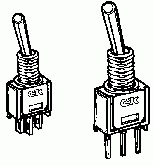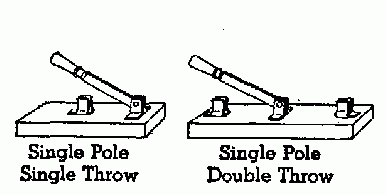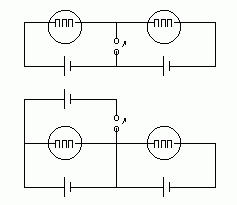EP-2 SWITCHES
 |
| Fig. 1. SPDT bat handle toggle switches. |
|---|
1. PURPOSE:
To study the function of switches in simple circuits
2. APPARATUS:
Two identical automotive-type 12 volt lamps of low power rating, three lamp sockets, 6 volt DC or AC source
One SPST knife switch, two SPDT knife switches, one DPDT knife switch, fuse, two lamp sockets.
 |
 |
| Fig. 2. Knife switches. | |
|---|---|
3. PROCEDURE:
In this exercise you will be posed a series of problems about switches and lamps. Figure out a way to accomplish each task, draw the circuit, and have it checked by the instructor. Then, if it is approved, wire it and test it.
(1) First, connect the power source and fuse in series and leave them connected for the entire experiment.
(2) Connect the power source, one lamp and one SPST switch so that the switch turns the lamp on and off.
(3) Connect the power source, one lamp and two switches so that each switch controls the lamp independently. That is, each switch will turn the lamp on and off without regard to the setting of the other switch. A practical application of this is a light in a room controlled by switches near two doors, or a light controlled by switches at the bottom and top of a stairway.
(4) Modify the circuit of part 3 by adding one DPDT knife switch so that each of the three switches can control the lamp independently. Such a circuit is often used in house wiring when a room lamp must be controlled from three locations.
(5) The same principle can be used to control one lamp from any number of switches. Two switches can be SPDT, all of the others must be DPDT. Electrical supply stores sell SPDT switches as "two-way" switches, the DPDT, specially wired internally, are called "three-way".
(6) Devise a circuit such that one switch toggles two lamps from series to parallel connection. A DPDT switch will be required. Be especially careful to avoid a circuit which shorts out one of the lamps!
(7) If you find one circuit which satisfies the conditions of part 6, now find another different circuit to do the same thing.
(8) Puzzle: You are given three resistors permanently soldered in a series string. How can you connect them in parallel by adding wires, but without disconnecting or unsoldering the series string.
(9) Puzzles: Consider these circuits:
 |
| Fig. 3. Circuit puzzles A (top) and B (bottom). |
|---|
All of these lamps are identical. The cells are identical (equal emf and equal internal resistance). With the switch open, both lamps burn equally brightly. What will happen when the switch is closed?
a) Both lamps burn brighter.
b) Both lamps burn less brightly.
c) The lamps remain at the same brightness as before.
d) The two lamps burn at different brightness.
© 1996, 2004 by Donald E. Simanek.